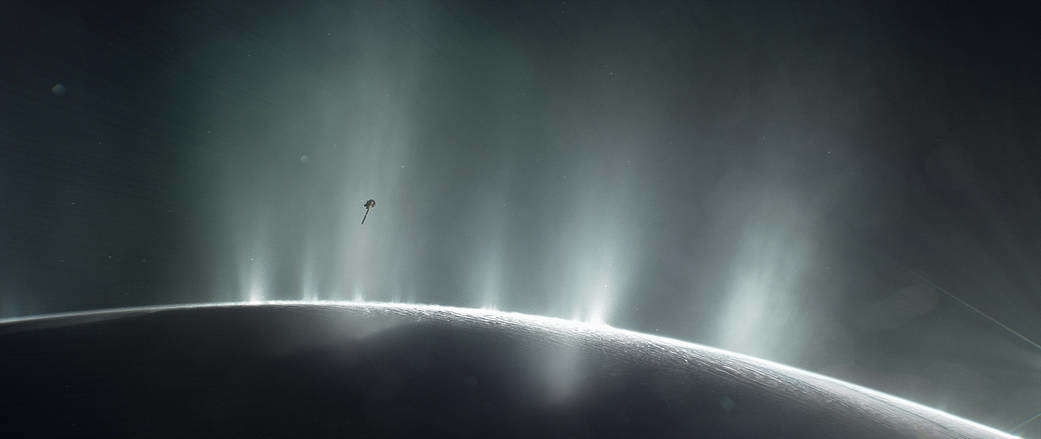Create a free profile to get unlimited access to exclusive videos, sweepstakes, and more!
Could the methane Enceladus spews into space mean aliens are lurking beneath the ice?

If you want to believe, the truth may be out there on Enceladus, whose thick icy crust covers a vast ocean that could be swarming with life—or not.
The plumes Enceladus spews into space have already been found to be made of water vapor. Anything with water could mean life (at least as we know it), which explains why so many scientists and space geeks alike are anxious to find out if anything can spawn on Saturn’s frozen moon, and now new research has found what may or may not be a biosignature. There is methane in those vaporous plumes. It could be a by-product of microbes similar to the ones living around hydrothermal vents at the bottom of the ocean on Earth.
Finding out whether there is actually life beneath that alien ice means we are going to have to send some sort of aquatic spacecraft over there. Astrobiologists from Paris Sciences & Letters University and the University of Arizona led a study recently published in Nature Astronomy, and while study lead Antonin Affholder believes more investigation is needed here, extraterrestrials shouldn’t be ruled out yet.
“After simulating hydrothermal vents on Enceladus, our results show that the most plausible scenarios correspond to a relatively high dihydrogen concentration in serpentinization fluids, similar to what we have on Earth,” Affholder told SYFY WIRE, “but it is still hard to compare conditions on Earth and Enceladus.”
Even if hydrothermal vents on Enceladus appear similar to those on our planet, there are still differences that stand out. No plumes come gushing out of hydrothermal vents on Earth. Heated by liquid magma in the mantle, warm water that allows life to thrive in what would otherwise be a cold and inhospitable environment usually never makes it to the surface. This is mostly because of the different zones in Earth’s oceans. Here, water near the surface is warmer, lighter and less salty, growing heavier, colder and saltier the further down. The ocean of Enceladus may not be stratified like this.
Affholder and his team used assumed similarities between hydrothermal vents on Earth and Enceladus to create simulations. Say that Encleadus’ hydrothermal vents have a similar chemistry. That would mean the fluids they release are capable of serpentinization, a process that morphs rocks from Earth’s mantle (which ended up on the seafloor from the shifting of tectonic plates) into serpentinites, which are mostly made of magnesium silicates and appear like the scales of a snake. The end result is a plume made of dihydrogen (H2) and methane (CH4). If this is really what happens on Enceladus, the chemistry is eerily similar to Earth’s.
“The methanogens we model in the study are a part of this group mainly composed of microbes,” Affholder said. “Such chemoautotrophs accelerate chemical reactions to acquire energy, and We combined these models in our biological model that was in turn combined with a model of water circulation around a hydrothermal vent.”
Any organism that gets its energy from a chemical reaction is a chemoautotroph. These ancient organisms are microbes, often found around hydrothermal vents, that need the carbon from carbon dioxide to survive, and can obtain that carbon from inorganic materials. Methanogenic microbes are those that produce methane. When the researchers looked at what effect a microbial population would have on its environment, they found that methanogens could impact how much dihydrogen and methane showed up in data from the Cassini probe. The simulations and Cassini measurements were not too far off.
Methane on bodies other than Earth was previously thought to come from non-biological reactions, but the simulations showed that the origin of all this methane may actually be from micro-creatures that eat rocks and break them down. What was really surprising was that the high levels of methane shown by the simulations couldn’t be reached with abiotic processes. While the source of methane remains a mystery, Affholder believes Enceladus could be hiding microbial life-forms.
“Methanogenic microbes might be a good candidate because they can explain the methane levels and because the H2 levels are indicative of a habitable environment,” he said, “but whether such a life form is actually the source of methane (rather than another abiotic process) is still unknown.”














